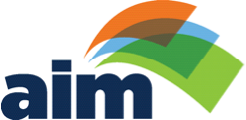The Road to Recovery
As we move down the road to a post-pandemic physical and economic development, there are still a number of challenges for employers. AIM will continue to provide updates and resources to assist you through this transition.
Please be sure to bookmark this page and check frequently
AIM Resources
AIM Employer Hotline
- Inquire regarding membership here.
AIM Protective Equipment & Service
Vaccines
- Click here to provide vaccinations for your employees
Mobile On-site Employer Vaccination Clinics
Employers who have confirmed 35 or more employees that will obtain a vaccine can request a mobile on-site vaccination clinic. A vaccine provider will come on-site to the employer’s location to vaccinate workers and return 3-4 weeks later with a second dose. To secure an onsite visit, employers will need to provide the following: address of the employer and a contact person, the number of confirmed employees, an indoor or outdoor space for the pop-up clinic, the type of appointment registration, and the requested date and time.
Employers should use this form for booking on–site visits. Priority will be based on the number of employees seeking vaccination and the location of the employers. An employer in a location with vaccination rates below the state average will be prioritized.
Additionally, AIM members can sign up for onsite visits and dedicates time slots for their employees through CIC Health and fill out this form. Individuals can also sign up for free Lyft rides to or from vaccine CIC-sponsored vaccine locations here.
Please reach out to Sam Larson with questions or if you are interested in joining AIM’s Reopening Taskforce. The task force meets monthly to discuss reopening regulations and options for employers during the COVID-19 recovery.
The federal CARES Act provides the following Unemployment Insurance provisions:
- $260 billion for increased unemployment assistance, including up to four months of full replacement wages up to certain limits for individuals who lose a job or are furloughed.
- Pandemic Unemployment Assistance (PUA) provides unemployment benefits to individuals who do not qualify for regular unemployment compensation and are unable to work because of the COVID-19 public health emergency. Qualified individuals may include self-employed workers (including gig workers and independent contractors), part-time workers, and those with limited work histories. The changes to increase the size of regular unemployment benefits and make them available for additional weeks will also apply to benefits received through the PUA program. PUA will be state-administered but fully federally funded. The program is effective through December 31, 2020.
- Pandemic Emergency Unemployment Compensation makes an additional 13 weeks of federally funded unemployment compensation available to individuals who have exhausted their state unemployment benefits available immediately through December 31, 2020.
- Emergency Unemployment Relief for Governmental Entities and Nonprofit Organizations reduces the amount that nonprofits, Indian Tribes, and governmental entities are required to reimburse states for benefits paid to their workers who claim unemployment insurance by 50 percent through December 31, 2020.
- Emergency Increase in Unemployment Compensation added $600 in Federal Pandemic Unemployment Compensation to every weekly unemployment benefit, effective until July 31, 2020. This $600 benefit is taxable (like regular unemployment benefits), but it will be disregarded in determining Medicaid or CHIP eligibility.
- Temporary Full Federal Funding of the First Week of Compensable Regular Unemployment for States with No Waiting Week allows states to enter into an agreement with the federal government to receive full reimbursement for the total amount of unemployment compensation paid to individuals for their first week of unemployment, provided that the state does not have a waiting week between applying for and receiving benefits, effective until December 31, 2020. (Which was included in the Massachusetts legislation explained above).
- Temporary Financing of Short-Time Compensation in States with Programs in Law would provide 100 percent federal reimbursement to states for payments made under qualifying short-time compensation programs (also known as work-sharing programs) through December 31, 2020.
Unemployment Insurance
Did You Know?
Paid Family and Medical Leave
AIM is currently monitoring federal negotiations regarding additional stimulus legislation possibly before or after January 2021, which may impact FFCRA and pending deadlines in December 2020.
The U.S. Department of Labor’s Wage and Hour Division (WHD) announced its first round of published guidance to provide information to employees and employers about how each will be able to take advantage of the protections and relief offered by the Families First Coronavirus Response Act (FFCRA) which took effect on April 1.
FFCRA applies to businesses with fewer than 500 employees to provide employees with paid leave, either for the employee’s own health needs or to care for family members. Documents provide guidance such as how an employer must count the number of employees to determine coverage; how small businesses can obtain an exemption, count hours for part-time employees; and calculate the wages employees are entitled to under this law.
The guidance is just the first round of information and compliance assistance to come from WHD. A workplace poster required for most employers will be published later this week, along with additional fact sheets and more Q&A.
Paid Family and Medical Leave
Resources
AIM Tracks Federal Negotiation
Click here for additional background on those negotiations. AIM will continue to provide you with updates should change to the FFCRA arise.
Federal Guidance
Federal Q&A
- Click here for the Federal Q&A
Department of Labor Enforcement
- Click here for enforcement or call 866-4US-WAGE
FCRA Guidance
- Click here for initial guidance on FFCRA
Legislative Summaries
AIM member audits and law firms have produced great summaries of this legislation.
- (Text Of Legislation)
- Summary & Analysis by PWC & Deloitte
- FAQ, Guide for Business Emergency Preparedness, and FoleyHoag.
American Rescue Plan Act Guidance
Specific Categories of Eligible Use
Public Health
Funding COVID-19 mitigation efforts, medical expenses, behavioral healthcare, and certain public health and safety staff.
Address Negative Economic Impacts
Includes economic harms to workers, households, small businesses, impacted industries, and the public sector.
- Delivering assistance to workers and families, including aid to unemployed workers and job training, as well as aid to households facing food, housing, or other financial insecurity. In addition, these funds can support survivor’s benefits for family members of COVID-19 victims.
- Supporting small businesses, helping them address financial challenges caused by the pandemic and making investments in COVID-19 prevention and mitigation tactics, and providing technical assistance. To achieve these goals, recipients may employ this funding to execute a broad array of loan, grant, in-kind assistance, and counseling programs to enable small businesses to rebound from the downturn.
- Speeding the recovery of the tourism, travel, and hospitality sectors, supporting industries that were particularly hard-hit by the COVID-19 emergency and are just now beginning to mend. Similarly impacted sectors within a local area are also eligible for support.
- Rebuilding public sector capacity, by rehiring public sector staff and replenishing unemployment insurance (UI) trust funds, in each case up to pre-pandemic levels. Recipients may also use this funding to build their internal capacity to successfully implement economic relief programs, with investments in data analysis, targeted outreach, technology infrastructure, and impact evaluations.
Replace Lost Public Sector Revenue
Using this funding to provide government services to the extent of the reduction in revenue experienced due to the pandemic.
Premium Pay for Essential Workers
Offering additional support to those who have borne and will bear the greatest health risks because of their service in critical infrastructure sectors.
Water, Sewer, and Broadband infrastructure
Making necessary investments to improve access to clean drinking water, support vital wastewater and stormwater infrastructure, and expand access to broadband internet.
More Information
States cannot use the money to offset operating expenses and then cut taxes. If a state does cut taxes, it will have to demonstrate to the Treasury Department that it offset that lost revenue with spending cuts or another source of revenue that does not include the fiscal recovery funds. The treasury reserves to right to claw back money it deems improperly spent. States can also not deposit ARPA dollars into pension funds or rainy-day funds. More information is available on the Treasury’s Website.



